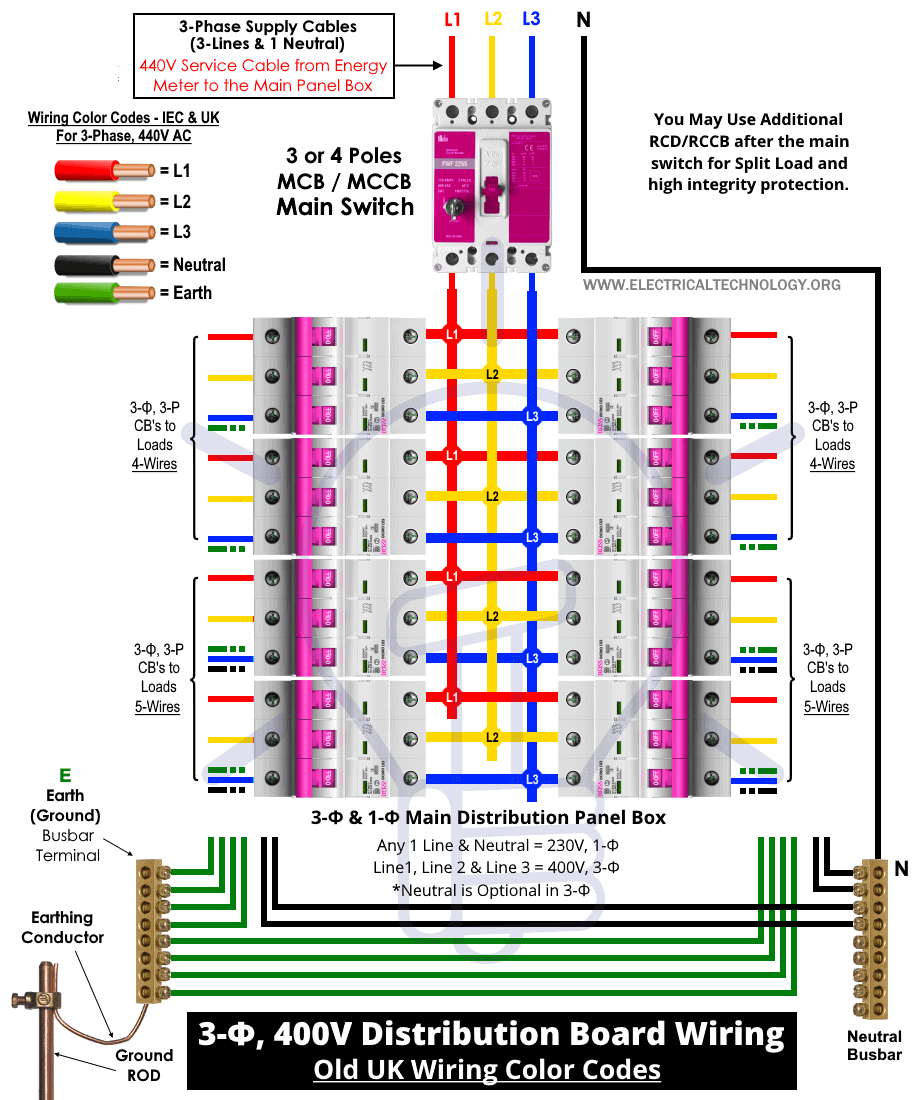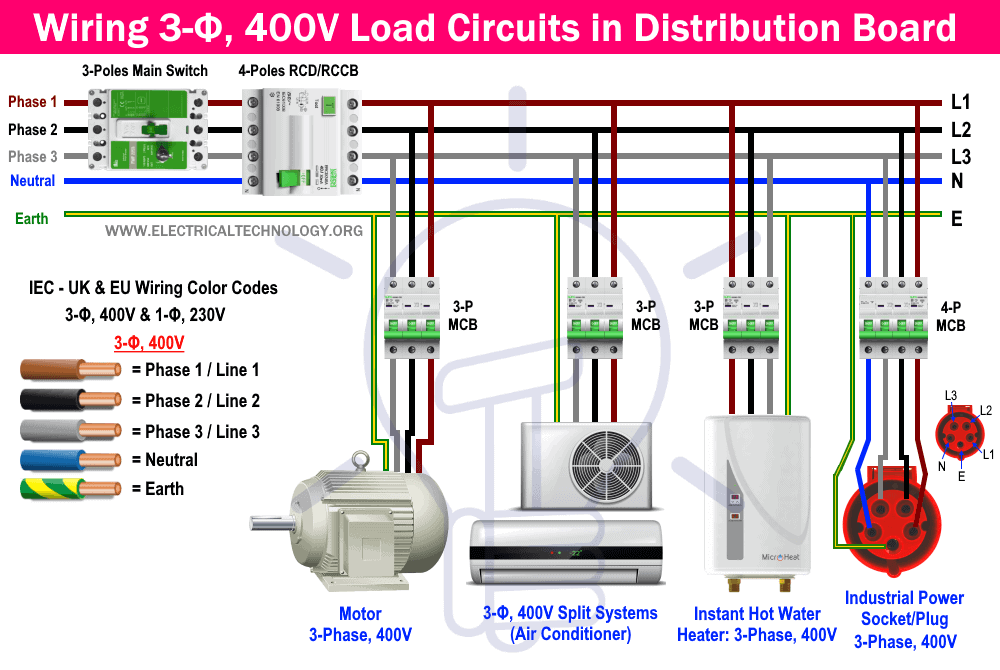How to Wire a Three Phase, 400V Distribution Board? IEC & UK
Wiring a 3-Phase, 400V Distribution Board: UK & EU – IEC
Three Phase Distribution Board
A distribution board is the combination of protective devices such as Main switch, MCB, MCCB, RCD, RCBO, Isolator, Fuses and Switches etc. used to control and safely distribute the power supply to the electric appliances and devices.
A distribution board is also known as main breaker box, electric panel or panel board used in commercial (as industrial) and domestic (as residential) applications to fulfill the need of safe electrical installations and distribution.
In UK, EU and other countries following the IEC rules, the voltage between three phases (L1, L2, and L3) are 400V, Three Phase (4 or 5 Wires) while the voltage between any Phase and Neutral is 230V AC (2 and mostly three Wires including the protective earth “E”). This way, a three phase distribution can also provide single phase supply from any phase and neutral.
We already know the difference between single phase and three phase power supply as well as balanced and unbalanced loads system, so we will never repeat them again. Please note that we have only three phase MCB and load points in this panelboard as we have already discussed the single phase, split load, dual split load and combination of single phase and three phase distribution board and consumer unit wiring tutorials. Now let’s move to the wiring installation of only three phase loads and distribution board.
Related Posts:
- How to Wire Combo of 3 & 1-Φ, 400V/230V Distribution Board?
- How to Wire 1-Phase Split Load Consumer Unit? – RCD+RCBO
- How to Wire 230V Dual Split Load Consumer Unit? – RCD+MCB
How to Wire a Three-Phase Distribution Board?
As shown in the fig, the three phase, 400V (Three Lines + Neutral) service cable (from the secondary of Star or Y connected transformer (fed up by the secondary of delta connected power transformer) mounted on the utility (pole having 11kV voltage) and 3-phase kWh energy meter) enters to the main distribution board.
All the three Lines (Phases) are connected to the three or four pole main switch MCB (Miniature Circuit Breaker) or MCCB (Molded Case Circuit Breaker). In case of 4 poles MCB/MCCB, the neutral should be connected to the neutral terminal mentioned on the breaker otherwise, connect the neutral directly to the neutral busbar terminal in the panel.
For enhanced and integrated protection, you may connect four poles RCD/RCCB right after the main switch. You may do the same for split load or dual split load distribution boards to transfer and separate the load points which depend only on a single RCD. We will discuss this scenario in our next post for 3-phase split load distribution board wiring installation.
All the 12 No. of three poles MCB’s are connected to each live busbar i.e. Phase 1 or Line 1 as brown, Phase 2 or Line 3 as Black, Phase 3 or Line 3 as Gray. Keep in mind that Earth/Ground is must while Neutral is optional and depends on the system design especially in three phase load distribution.
For example, a three phase motor can be directly connected to all the three phases via 4-wires while an industrial power socket/plug having five terminals can be connected via 5 wires (including All three phases + neutral + earth wire).
Related Posts:
- How to Wire 120V & 240V Main Panel? Breaker Box Installation
- How to Wire 208V & 120V, 1-Phase & 3-Phase Main Panel?
The following wiring diagram shows all the three phase loads and 3-Poles MCB’s for 400V AC supply system e.g. 4 No of three poles MCB’s on the right side of the breaker bank while 4 No of three poles MCB’s on the left side.
In short, 4 No. of MCB’s are wired for 4-wires (Three Lines + Ground) while the rest 4 No of MCB’s are wired for 5-Wires (Three Lines + Neutral + Earth).
Click image to enlarge
Related Post:
- How to Wire Single-Phase, 230V Consumer Unit with RCD? IEC, UK & EU
- Single Phase Electrical Wiring Installation in Home – NEC & IEC
- Three Phase Electrical Wiring Installation in Home – NEC & IEC
400V Distribution Board Wiring – Old UK Wiring Color Codes
Some of the readers requested in the page inbox as well as email to include the Old UK wiring color codes (UK now using IEC wiring color codes) for three phase and single phase distribution boards and consumer unit as the same wiring codes are still applicable in many countries including India, Pakistan, United Arab Emirate, Saudi Arabia etc. So, here is the three phase distribution wiring according to old United Kingdom Wiring color codes (prior-2004).
Click image to enlarge
Related Posts:
- Single-Phase Electrical Wiring installation in a Multi-Story Building
- 3-Phase & 1-Phase Electrical Distribution Wiring Installation in Multistory Building
Wiring 3-Φ, 400V Load Circuits in Distribution Board
In a three phase distribution board, all the three phase, 400V load points can be connected directly to the three phases (L1, L2 & L3) with proper Earthing/Grounding wire. Keep in mind that Neutral is not always needed in a three phase system as it depends on the system design and operation.
Three Phase 400V Appliances and MCB’s
- Three Phase Motor, Split Air-conditioner Systems and Instant Water Heater via Three Poles MCB: Four Wires i.e. 3-Lines + Ground)
- Industrial Power Socket/Plug having five terminals via Four Poles MCB: Five Wires i.e. 3-Lines, + Neutral + Earth/Ground.
Good to know: We have only shown the three phase distribution wiring for 440V, three phase load points. A 230V, single phase load can also be connected through an Line and Neutral (including the protective earth). You may check our previous tutorials on single phase consumer unit and distribution wiring diagrams.
Click image to enlarge
Related Posts:
- How to Wire 240V, 208V & 120V, 1 & 3-Phase, High Leg Delta Main Panel?
- How to Wire 277V & 480V, 1-Phase & 3-Phase, Commercial Main Service Panel?
IEC Wiring Color Codes: 400V, 3-Φ: UK & EU
We have used the following IEC wiring color codes for 400V three phase supply voltage applicable in the UK & EU.
IEC Wiring Color Codes for 400V, 3-Phase, 4/5-Wire System
- Brown = Phase 1 or Line
- Black = Phase 2 or Line 2
- Gray = Phase 3 or Line 3
- Blue = Neutral
- Green or Green with Yellow Stripe = Earth or Ground wire as protective earth (PE).
For single phase 230V, Brown for Phase and Blue for Neutral are used.
The Old UK wiring Color Codes for Three Phase Wiring
400V Three Phase
- Red = Phase 1
- Yellow = Phase 2
- Blue = Phase 3
- Black = Neutral
- Green = Earth or Ground wire.
For single phase 230V, Red for Phase and Black for Neutral are used.
Related Posts:
Instruction & Safety Precautions
- Disconnect the power supply (and make sure it is really swathed OFF) before servicing, repairing or installing electrical equipment. To do so, switch off the main switch in the main consumer unit or distribution board.
- Never stand or touch wet and metal parts while repairing or installation.
- Read carefully all the cautions and instructions and follow them strictly while doing this tutorial or any other work in practical related to electrical works.
- Always, use the right size cable and wire, proper size outlets and switch and suitable size of circuit breakers. You may also use the Wire and Cable size calculator to find the right gauge size.
- Never ever try to play with electricity (as it is dangerous and can be fatal) without proper guidance and care. Do the installation and repairing work in presence of experienced persons having vast knowledge and good practice who knows how to deal with electricity.
- Doing your own electrical work is dangerous as well as illegal in some cases. Contact the licensed electrician or the electric power supply provider before practicing any change/modification in electrical wiring connections.
- The distribution board should not be installed 2.2 meter above the floor, must be protected from the corrosion and away from watery areas. All the wires should be covered in the panel board (i.e. it should not hang outside the panel). Finally, there must be a safety sign near the distribution board.
- The author will not be liable for any losses, injuries, or damages from the display or use of this information or if you try any circuit in wrong format. So please! Be careful because it’s all about electricity and electricity is too dangerous.
Related Wiring Installation Tutorials:
- How to Wire and Install an Electrical Outlet Receptacle?
- How to wire a GFCI Outlet?
- How to Wire an AFCI Outlet?
- How to Wire Combo Switch and Outlet?
- How to Wire GFCI Combo Switch and Outlet
- How to Wire an AFCI Combo Switch
- How to Wire a GFCI Circuit Breaker?
- How to Wire an AFCI Breaker?
- Staircase Wiring Circuit Diagram – How to Control a Lamp from 2 Places?
- Corridor Wiring Circuit Diagram – Hallway Wiring using 2-Way Switches
- Tunnel Wiring Circuit Diagram for Light Control using Switches
- Hospital Wiring Circuit for Light Control using Switches
- Hotel Wiring Circuit – Bell Indicator Circuit for Hotelling
- Hostel Wiring Circuit Diagram and Working
- Godown Wiring Diagram – Tunnel Wiring Circuit and Working
- How to Wire 120V Water Heater Thermostat – Non-Simultaneous?
- Even More Electrical Wiring Installation & Tutorials









